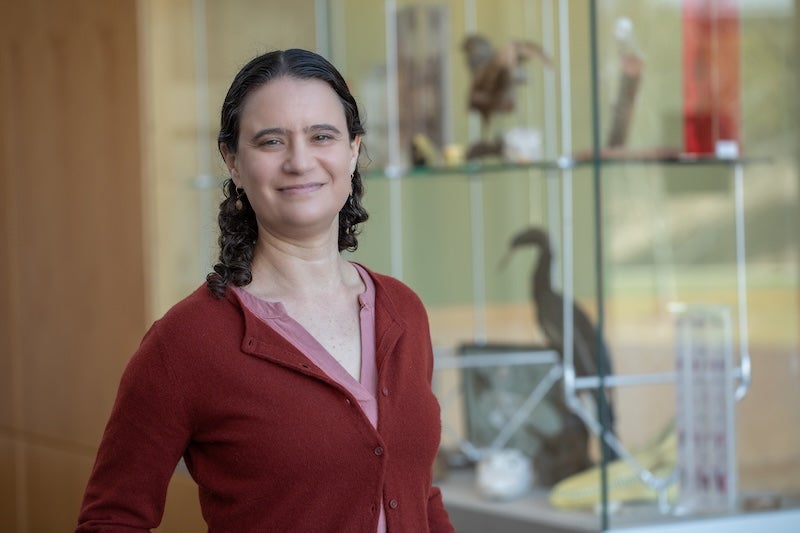Rachel Schwartz is an associate professor in URI’s Department of Biological Sciences who teaches Genetics, Big Data Analysis, and a variety of hands-on courses to help students learn to do research and analyze data. Professor Schwartz is interested in training researchers to efficiently and effectively manage and analyze their data, as well as to apply novel methods that she is developing to understand genome diversity and evolution.
Q. How would you describe your teaching philosophy, and how do you help students work through the complex material in your courses?
A. My goal is to focus on student learning. I try to set up projects that support students to think through and understand ideas. I taught a course this Spring semester that included a unit where students were working with SARS-CoV-2 genomes (the virus that causes COVID). They were working with real data and went through a series of directed steps to look at mutations in real samples and identify variants such as Delta and Omicron. At the end, they presented what they learned. This course is essentially learning about doing research and science, but there’s a lot of content in a process like this: they’re learning about DNA, transcription and translation, codons and amino acids, and evolutionary questions. If you want to be able to explain what happened in the evolution of the SARS-CoV-2 virus, you have to understand a variety of ideas in genetics at the level that you can explain it in this context, not just in the abstract.
Q. What has been the most surprising or unexpected part of teaching?
A. Every student is different and it has been amazing to see how they are successful and excited in different ways. I have students who are successful in a traditional way: they figure stuff out, learn the material, answer the questions, and do well on exams. But there are other students who come in and ask different kinds of questions that are sometimes even more exciting. They might struggle under the traditional academic metric of measuring success, but they’re interested, engaged, and hard working, and I enjoy watching them learn. Having a range of students who bring different backgrounds, experiences, and ideas to class makes me enjoy teaching more. The best thing about working with students is actually seeing them succeed later outside my classroom using what they have learned and experienced in class.
Q. How do you incorporate hands-on learning into your courses?
A. My smaller classes all incorporate hands-on experiences. I regularly teach a course where students learn to analyze large datasets using computational tools, and we work with real datasets from the very beginning of class. Students work on processing, modeling, and visualizing data. Their exams are all set up around taking the skills from the class and being able to independently analyze data in the same way they would in their own research projects. I’ve also taught a couple of research-based courses where students work through the same data that professional researchers use and answer the same research questions by using the same methods. These are skills that translate directly into novel research in a lab if they are interested in that direction, but they also help all students understand how science is done so that if they read about the latest research in a newspaper they get how that happened.
Q. Why do you think it’s important to teach about genetics and/or biological sciences?
A. Genetics is key to a lot of what we experience in life. Almost everyone will run into some situation related to genetics, such as having their DNA sequenced by 23andMe and needing to know why they have a particular risk for a disease or how relatives are identified. Someone considering having children may consider prenatal testing for genetic disorders. We have seen a lot of genetics in the news related to COVID-19 as new variants emerged due to new genetic mutations.
However, learning genetics, and biology more broadly, goes beyond learning content these days. A lot of what we’re doing in college is developing students’ higher-level thinking skills and teaching them how to apply content to real-world scenarios, ensuring they can integrate and apply knowledge effectively. You can go look up anything on the internet nowadays. You can google any sort of fact about genetics. YouTube videos are probably way more fun and animated than most of what I can deliver in a lecture, but being able to take little pieces of content and react to a newspaper article or real-life scenario and to ask yourself if you’re getting correct information or what you can do with that information comes back to the higher level thinking skills we’re trying to build in college.
Q. How has your research influenced your teaching?
A. I wouldn’t be able to help students learn the latest methods, work with the latest data, or think through research ideas if I wasn’t doing those things myself. While I don’t personally do research on COVID, basic ideas behind the project that we worked on in class are the things I think about in my own research. How do we trace evolutionary history? How do we analyze data to draw conclusions? How do we set up research to develop a proposal? I think the really fun part of science is being able to think about what your question is and how you go about answering it. I want students to become excited about doing science and analyzing data to draw conclusions.

